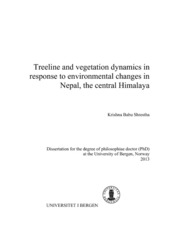| dc.contributor.author | Shrestha, Krishna Babu | eng |
| dc.date.accessioned | 2013-09-12T08:49:20Z | |
| dc.date.available | 2013-09-12T08:49:20Z | |
| dc.date.issued | 2013-05-31 | eng |
| dc.identifier.isbn | 978-82-308-2305-7 | en_US |
| dc.identifier.uri | http://hdl.handle.net/1956/7127 | |
| dc.description.abstract | Aims: To describe and evaluate patterns of vegetation response to ongoing environmental changes across climate-limited (alpine treeline ecotone) and humanmodified (temperate Himalayan oak forests) ecosystems in Nepal, central Himalaya. Methods: I used dendroclimatological techniques to examine spatial and temporal changes in tree growth responses (paper I) and recruitment patterns (paper II) to climatic variability across a dry Pinus wallichiana and a mesic Abies spectabilis treeline ecotone. Trees from various ecological elevations (forest line, treeline and krummholz line) were cored, annual growth was measured and site chronology was developed for analysing climate-growth relationships. Transects were laid out between the forest line and tree species line, crossing the treeline. Seedlings, saplings and trees were sampled in each transect for age analysis. Alpha, beta and gamma diversity were studied across a forest border from a forested to open landscape in a subalpine-alpine region (paper III) and an anthropogenic disturbance gradient (paper IV). Vascular plant species richness and environmental variables were recorded in each plot (10 m × 10 m). Alpha diversity was estimated as average species richness per plot. Beta diversity was based on gradient length estimated by Detrended Correspondense Analysis (DCA). Gamma diversity was estimated as total species number present in the landscape. Main results: At the dry locality, tree growth at the forest line responded positively to warm summers and after cold winters: possibly a response to early onset of growing season. At the mesic locality, growth at lower altitudes (forest line) showed signals of drought limitation, whereas at higher altitudes, decreased growth was associated with an early onset of the monsoon. Reduced growth at the treeline was related to the high winter snow fall and delayed onset of growing season. The current treelines in both areas have remained stationary over the decades. Climate and land-use are both important factors for treeline structuring processes. Number of trees and saplings in the dry area is higher compared to the mesic area suggesting that tree establishment rate is higher in the dry area giving a higher potential for treeline advance. In a set of vertical transects sampled across the forest line, a positive correlation between canopy and temperature gradients was found. Detrended Correspondence Analysis revealed low species turnover and a continuum in species composition across the forest border ecotone. The low species turnover and minor differences in alpha diversity could be attributed to human influence. Furthermore, in differently disturbed Quercus semecarpifolia forest at Phulchoki and Ghorepani, alpha and gamma diversity show a unimodal response to disturbance gradient. Linear relationships were observed between beta diversities (ßSD and ßA) and disturbance gradient. Conclusion: Climate signals in the pattern of tree growth responses and recruitment are site-specific. Both growing season as well as non-growing season climate factors are important drivers for vegetation changes, but they vary between study areas, with altitude and with time scale (whole time-periods vs. decadal periods). Species diversity changes along environmental gradients with spatial as well as temporal scales. Further perspective: The Himalaya are under-represented in studies of vegetationclimate relationships. The main reason is logistic challenges and lack of reliable climate data from desired locations. Future research of a similar nature to the present study should include more than one species sharing the same environment, and investigate these same species in various geographic regions and ecological settings. Impacts on the ecosystem level can be investigated by quantifying and examining species diversity and other ecosystem level responses (e.g. carbon sequestration). | en_US |
| dc.language.iso | eng | eng |
| dc.publisher | The University of Bergen | en_US |
| dc.relation.haspart | Paper I: Shrestha, K. B., Hofgaard, A. and Vandvik, V. Tree growth response to climatic variability in two climatically contrasting treeline ecotone areas, central Himalaya, Nepal. Article not available in BORA. | en_US |
| dc.relation.haspart | Paper II: Shrestha, K. B., Hofgaard, A. and Vandvik, V. Treeline dynamics in dry and mesic areas of Nepal, central Himalaya. Article not available in BORA. | en_US |
| dc.relation.haspart | Paper III: Shrestha, K. B. and Vetaas, O. R. (2009): The forest ecotone effect on species richness in an arid trans-Himalayan landscape of Nepal. Folia Geobotanica 44(3), 247-262. Article not available in BORA due to publisher restrictions. The published version is available at: <a href="http://dx.doi.org/10.1007/s12224-009-9046-9" target="blank"> http://dx.doi.org/10.1007/s12224-009-9046-9</a> | en_US |
| dc.relation.haspart | Paper IV: Shrestha, K. B., Måren, I. E., Arneberg, E., Sah, J. P. and Vetaas, O. R. (2013): Effect of anthropogenic disturbance on plant species richness in oak forests in Nepal, central Himalaya. International Journal of Biodiversity Science, Ecosystem Services & Management 9(1), 21-29. Article not available in BORA due to publisher restrictions. The published version is available at: <a href="http://dx.doi.org/10.1080/21513732.2012.749303" target="blank">http://dx.doi.org/10.1080/21513732.2012.749303</a> | en_US |
| dc.subject | Alpha-diversity | eng |
| dc.subject | Beta-diversity | eng |
| dc.subject | Climate change | eng |
| dc.subject | Dendrochronology | eng |
| dc.subject | Dendroclimatology | eng |
| dc.subject | Disturbance | eng |
| dc.subject | Diversity | eng |
| dc.subject | Ecotone | eng |
| dc.subject | Environmental change | eng |
| dc.subject | Forest line | eng |
| dc.subject | Gamma-diversity | eng |
| dc.subject | Land-use | eng |
| dc.subject | Mass effect | eng |
| dc.subject | Species richness | eng |
| dc.subject | Tree-ring | eng |
| dc.subject | Treeline | eng |
| dc.title | Treeline and vegetation dynamics in response to environmental changes in Nepal, the central Himalaya | en_US |
| dc.type | Doctoral thesis | |
| dc.rights.holder | Copyright the author. All rights reserved | en_US |
